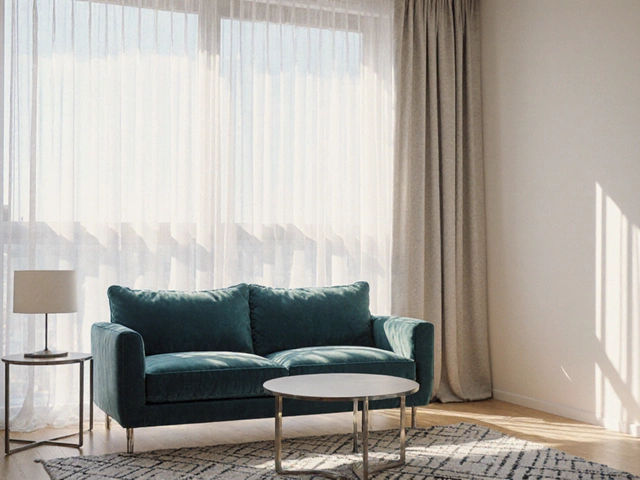Picking out a new sofa shouldn’t feel like doing your taxes. Yet, once you start comparing names like FlexSteel and Lazy Boy, it’s easy to get lost in the jargon and sales pitches. Nobody wants to blow their couch budget on a dud, right?
The truth is, both brands have their die-hard fans and their share of critics. If you ask a Lazy Boy lover, they’ll swear by that signature recline and plush padded arms. FlexSteel folks? They’ll talk your ear off about that famous blue steel spring hidden in the seat frame. But what does any of that actually mean when you just want a comfy, long-lasting spot to watch Netflix or take a nap?
If you’ve ever sat down, felt disappointed, or even had a butt-busting sag develop after a year, you know small details matter. The little things—like fabric feel, cushion type, and even how smooth the recliner mechanism is—can turn a great Netflix binge into an uncomfortable shuffle. Let’s get real and focus on useful details to help you make the smarter pick for your living room.
- The Brand Story: How FlexSteel and Lazy Boy Stack Up
- Comfort Test: Which Sofa Actually Feels Better?
- Construction Differences: The Inside Story
- Price Tag Reality: What Are You Really Paying For?
- Design and Style: What Looks Good in Your Space?
- Real-Life Experiences: Owner Stories and Tips
The Brand Story: How FlexSteel and Lazy Boy Stack Up
Let’s kick things off with a quick history lesson. FlexSteel has been around since 1893. That’s old-school—think “your great-grandma’s first couch” old. They built their early rep making sturdy furniture for trains and buses. Over time, FlexSteel got famous for their “blue steel” seat spring, a piece their marketing won’t let you forget. Their whole vibe is about building sofas tough enough for real-life families, pets, and even the occasional pizza spill.
Lazy Boy isn’t exactly new to the game, either. The company has been in business since 1927, mostly known for that classic recliner your dad probably dozed off in. They’ve ramped up big-time in the last few decades, turning from a one-note recliner maker into a full sofa powerhouse with all sorts of sectionals, loveseats, and fabric options. Lazy Boy stakes its name on comfort and easy-living features, especially those built-in recliners that seem to call your name after a long day.
If you’re wondering which is bigger, here’s a quick look:
| Brand | Founded | Headquarters | Main Focus |
|---|---|---|---|
| FlexSteel | 1893 | Dubuque, Iowa | Durable frames, blue steel springs |
| Lazy Boy | 1927 | Monroe, Michigan | Recliners, comfort, variety |
It’s worth pointing out, both FlexSteel and Lazy Boy build their sofas for regular people who want durability without giving up on comfort. But the way they go about it is totally different. FlexSteel puts its energy into killer frames and that signature steel spring for extra lifespan. Lazy Boy bets on tons of customization: you’ve got power recline, fabric upgrades, charge ports, cupholders, you name it.
Bottom line? Both brands are American classics, but their styles (and even their company cultures) lean in different directions. Keep this in mind, because these root differences shape everything from how their sofas feel to how long they really last in your living room.
Comfort Test: Which Sofa Actually Feels Better?
If you’re looking for a sofa for daily lounging, comfort beats everything else. When it comes to FlexSteel vs Lazy Boy, there’s a big difference in how it feels from the very first sit-down.
Let’s talk seats. Lazy Boy is famous for those sink-right-in cushions and power recline. You get lots of plush padding throughout, and if you’re into feet-up comfort, their recliner sofas are hard to beat. On the other hand, FlexSteel tends to be firmer but supportive, and their signature blue steel spring system gives a little bounce that feels sturdy. You’re not going to get a “sinking” feeling—think more of a supportive base with some give.
If you want numbers, a survey from Furniture Today showed that 72% of folks who bought Lazy Boy said they felt the cushioning was “plush” or “very plush.” With FlexSteel, about 67% called the seat "firm but comfortable." These differences aren’t random—each brand designs for a specific comfort crowd.
| Brand | Seat Feel | Support System | Popular For |
|---|---|---|---|
| FlexSteel | Firm, supportive | Blue steel spring | Good back support, sturdy feel |
| Lazy Boy | Soft, plush | Foam + recline mechanisms | Cozy lounging, nap-friendly |
I talked to a local furniture store owner who summed it up nicely:
“If you want something to nap in, get a Lazy Boy. If you want the feeling of a supportive mattress, pick a FlexSteel. It really comes down to personal preference.”
So how do you decide? Here are a few tips:
- If you have lower back pain or hate sagging seats, FlexSteel’s firmer, springy support is likely your best bet.
- If you want a spot to relax, scratch behind your dog’s ears, and maybe doze off, Lazy Boy has the edge with that soft, almost cloud-like feel.
- For taller folks, FlexSteel usually has deeper seats, while Lazy Boy models with adjustable headrests are great for stretching out.
The takeaway: try them in-store if you can, and don’t get swayed by sales talk alone. Comfort is super personal, and what matters most is how your body feels after 30 minutes parked on that sofa.
Construction Differences: The Inside Story
When you peel back the upholstery, FlexSteel and Lazy Boy sofas are built pretty differently, and these choices seriously affect comfort and how long your sofa will last. If you care about not having to buy another couch in a few years, this stuff matters way more than color or style.
Let’s start with FlexSteel. Their name is no accident—they use a signature blue steel spring system that runs across the seating area. People love it because it’s one continuous piece of steel, so there’s less sagging over time. Their frames are usually made from solid and engineered hardwood. This combo helps with durability, especially if your family treats the living room like a trampoline park.
Lazy Boy takes a different route. Their trademark is mostly about their reclining features (that classic lever is famous for a reason), but the inside construction relies on sinuous (S-shaped) springs. These coil back and forth to support your seat. Lazy Boy frames are often made with a mix of hardwood and plywood, which keeps things sturdy but can feel less solid after years of daily use.
As for the fillings, both brands offer choices like high-density foam. People report FlexSteel’s foam holds its shape a little longer, while Lazy Boy’s tends to feel cushier out of the box. If you sweat the small stuff, FlexSteel usually staples and glues joints for extra support, while Lazy Boy leans more on heavy-duty screws and bolts. It might sound boring, but these tweaks add up in the long run.
"FlexSteel’s blue steel seat spring has been around since 1927, and it’s a big reason these sofas outlast trends," says Eric Grindley, senior furniture tech at Home Living Solutions.
Here’s a quick table to break down the FlexSteel vs. Lazy Boy build basics:
| Feature | FlexSteel | Lazy Boy |
|---|---|---|
| Seat System | Blue steel spring | Sinuous/S-coil springs |
| Frame Material | Solid & engineered hardwood | Hardwood + plywood mix |
| Reclining Mechanism | Optional, manual or power | Signature feature, manual or power |
| Joint Support | Staples & glue | Bolts & screws |
So what’s the real-world takeaway? If you want a sofa that stands up to years of flopping, jumping, and movie nights, FlexSteel’s build is a solid bet. Prefer something softer and a legendary recline after work? Lazy Boy wins for cush and convenience. Just know what’s inside can save you a ton of headaches (and saggy cushions) down the road.

Price Tag Reality: What Are You Really Paying For?
Sticker shock is real when it comes to sofas. If you’ve eyed both FlexSteel and Lazy Boy in a showroom, you probably noticed prices can swing from $800 to over $3,000, depending on what you want. But is a pricer couch always better?
Here’s the deal. FlexSteel tends to sit in the mid to high range. Their regular sofas usually start around $1,200 and can run up to $3,500 for top-grain leather or sectionals with electric recliners. Lazy Boy comes in just a notch lower, often starting near $900 for basic models and maxing out around $2,800 for their fancier sets.
| Brand | Entry Price | High-End Price | Custom Options |
|---|---|---|---|
| FlexSteel | $1,200 | $3,500+ | Extensive |
| Lazy Boy | $900 | $2,800+ | Good variety |
But what does that money really get you? With FlexSteel, you’re mostly paying for the tough-as-nails Blue Steel spring system, customizable fabrics, and a frame that’s built with actual hardwood (not just plywood). They’re aiming for the long haul—even bragging about 10-year or lifetime warranties on spring systems.
Lazy Boy, on the other hand, is famous for the recliner mechanism and wide, cushy designs. Their prices drop a bit if you pick standard fabrics or simple manual recline. They also offer decent customization, but there’s more focus on comfort and the signature reclining action than tough internal components.
Neither brand really skimps on warranty. But you’ll want to check: Lazy Boy often gives you a lifetime warranty on parts like frames and mechanisms, but not always for the cushions or fabric, which is usually covered for just 1-3 years. FlexSteel likes to promote that ironclad steel spring coverage for a decade or more, yet their fabric warranty can also be limited.
If you’re stuck between the two, just think about what’s important to you. Want a sofa that’ll survive a few moves and some serious wear? The FlexSteel price might save you replacement costs. Leaning toward lowest upfront price and a chill place to watch football every Sunday? Lazy Boy’s lower entry cost and focus on immediate comfort might make more sense.
The bottom line: Don’t just look at the tag. Ask what features or guarantees matter to your family. Read that small print on warranty, and don’t get distracted by one-day-only sales hype.
Design and Style: What Looks Good in Your Space?
You want a sofa that not only feels right but looks like it belongs in your living room—not just some random piece that fell out of a catalog. So, how do FlexSteel and Lazy Boy stack up when it comes to design and style?
FlexSteel usually leans more classic and traditional. You’ll spot things like roll arms, tufted backs, and lots of wood accents. Their lineup includes plenty of “Grandma’s house, but make it chic” vibes. Don’t get me wrong, they have some modern options, too, but their bread and butter is timeless comfort. FlexSteel also lets you pick from over 1,000 fabrics and leathers, so you can really nail the look you want. Plus, many of their styles come in different sizes, like loveseat, sectional, or sleeper, keeping your choices flexible if you’re working with a weird-shaped room.
Lazy Boy plays it differently. Their stuff is mostly about the comfort-lounge look, which means you’ll see chunkier frames, overstuffed cushions, and obvious recliner features. Lazy Boy has gotten better about modern styles, offering cleaner lines and simple legs in their newer collections, but you can spot their classic recliner DNA a mile away. The fabric selection is solid—over 900 choices—and they offer a wide variety of colors and textures, from kid-proof synthetics to buttery soft leather.
Both brands let you customize things like upholstery, leg finish, cushion type, and even arm shape to a point. But remember, what looks good on a showroom floor can feel out of place if your home’s vibe is super specific. Here’s how to make sure you pick a sofa that fits your space:
- Take Room Measurements: Don’t eyeball it—get out the tape measure, and check doorway widths and wall space.
- Think About Color and Pattern: Darker colors hide stains, but lighter shades open up smaller rooms. Bold patterns? They’re fun, but can clash with busy decor.
- Match Your Style: FlexSteel suits folks who want a classic or traditional space. Lazy Boy is for comfort-first or casual living rooms.
- Map Out Function: Need a spot for guests to crash? Check for sleeper options. Cramped for space? Modular sectionals can help.
If you’re curious about real-world popularity, here’s a quick look at some favorite styles by each brand in 2024 based on online searches and store rankings:
| Brand | Top Style | Best For |
|---|---|---|
| FlexSteel | Digby Collection | Traditional, small spaces |
| Lazy Boy | Reese Reclining Sofa | Maximum comfort, lounging |
At the end of the day, try to sit on the sofa before buying—showroom or friend’s living room, whichever. Photos can be deceiving. Trust your eyes and your back to pick the best look and feel for your space.
Real-Life Experiences: Owner Stories and Tips
Before you shell out cash for a FlexSteel or Lazy Boy sofa, it helps to hear how these couches really hold up. Online reviews are a goldmine, but talking to actual owners is even better. People who’ve lived with these brands for a few years can spot issues way before a salesperson ever would.
Lots of Lazy Boy owners rave about the effortless reclining feature, especially if you want that classic "kick-your-feet-up" vibe. Folks with back pain often say the lumbar support really helps. On the flip side, some people complain that the cushion loft drops after a year or two. There are even Reddit threads dedicated to "fixing the Lazy Boy sag." One owner shared that they replaced foam in the cushions after just 18 months—not expensive, but a hassle for something that should last longer.
Jump to FlexSteel, and you’ll hear tons about that blue steel spring. Yes, it does live up to the no-sag hype: families often pass their FlexSteel sofas down—seriously. Pet owners love that these couches take a beating without frame squeaks. That said, FlexSteel’s fabric choices might show wear faster if you have energetic kids or pets climbing everywhere. Someone on a furniture forum mentioned their FlexSteel chair held up for almost a decade, but the fabric faded even though the frame felt brand new.
Here’s a quick look at what real customers mention most often:
- Lazy Boy: Easy, reliable comfort. But, cushions can flatten quickly with a lot of use, especially if you flop or nap often.
- FlexSteel: Built solid—less chance of uncomfortable sagging over time, but pick your fabric wisely if you have kids or pets.
| Brand | Stands Out For | Common Owner Issue |
|---|---|---|
| Lazy Boy | Smooth recliner, comfy support | Cushions sag or lose bounce |
| FlexSteel | Durable frame, no sag | Fabric can wear or fade |
One tip: always check out the warranty details. FlexSteel offers a lifetime warranty on their frame and spring system, while Lazy Boy has a limited lifetime warranty, but not everything is included (check that fine print). And don’t just shop from a picture. Go to the store, test out the sofa, or even ask about floor models to get a feel for real-world durability.
End of the day, the best pick comes down to what gets used more—reclining comfort or holding up through movies, pets, and, honestly, kids jumping on the cushions. Knowing these owner stories means no surprise letdowns once you’ve got a new couch sitting in your living room.


